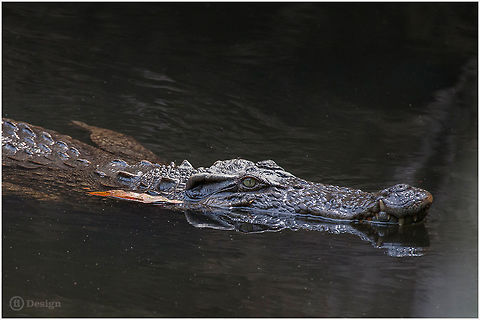
Appearance
The Siamese crocodile is a small, freshwater crocodilian, with a relatively broad, smooth snout and an elevated, bony crest behind each eye. Overall, it is an olive-green colour, with some variation to dark-green. Young specimens measure 1.2–1.5 m and weigh 6–12 kg, growing up to 2.1 m and a weight of 40–70 kg as an adult. The largest female specimens can measure 3.2 m and weight 150 kg. Large male specimens can reach 4 m and 350 kg in weight. Most adults do not exceed 3 m in length, although hybrids in captivity can grow much larger.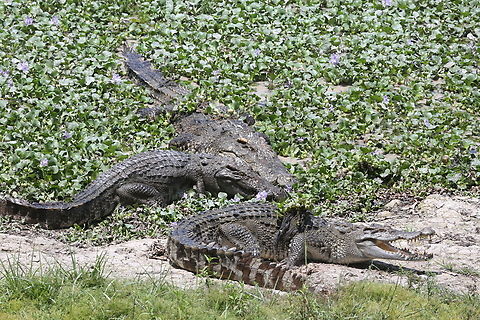
Naming
Its other common names include: Siamese freshwater crocodile, Singapore small-grain, "cocodrilo de Siam, crocodile du Siam, buaja, buaya kodok, chorakhe nam chuet," and soft-belly.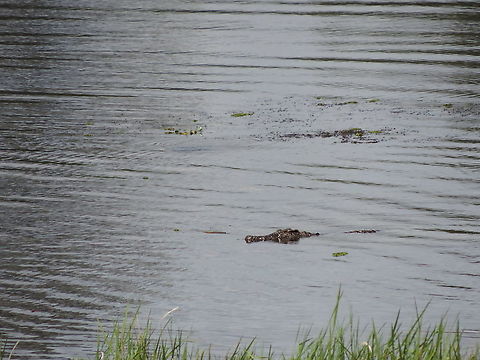
Distribution
The historic range of the Siamese crocodile included most of Southeast Asia. This species is now extinct in the wild or nearly extinct from most countries except Cambodia. Formerly it was found in Cambodia, Indonesia, Laos, Malaysia, Thailand, Vietnam, Brunei, and Burma.Siamese crocodiles occur in a wide range of freshwater habitats, including slow-moving rivers and streams, lakes, seasonal oxbow lakes, marshes and swamplands.
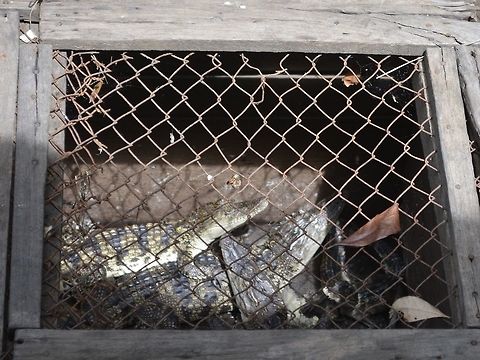
Status
This crocodile is classified as critically endangered on the IUCN Red List, and is listed on Appendix I of CITES.It is one of the most endangered crocodiles in the wild, although it is extensively bred in captivity.The current situation of "C. siamensis" represents a significant improvement from the status reported in the 1992 Action Plan, but poses major new challenges for quantitative survey and effective conservation action if the species is to survive. While the species remains critically endangered, there is a sufficient residual wild population, albeit severely fragmented across several areas and countries, to provide a basis for recovery.
The Siamese crocodile is relatively unthreatening to people, and the possibility of people and crocodiles coexisting in natural settings seems possible. The powerful economic force of the commercial industry based on "C. siamensis" also needs to be mobilised and channelled for conservation advantage. Considerable effort and action is still required, but the species has a reasonable chance of survival if the necessary actions can be implemented.
Yayasan Ulin is running a small project to conserve an important wetland habitat in the area of East Kalimantan which is known to contain the crocodiles. Most of them, though, live in Cambodia, where isolated, small groups are present in several remote areas of the Cardamom Mountains, in the southwest of the country, and also in the Vireakchey National Park, in the northeast of the country.
In Cambodia Fauna and Flora International and the Government of Cambodia's Forestry Administration have established the Cambodian Crocodile Conservation Programme for the protection and recovery of Siamese crocodiles. This programme works with a network of indigenous villages who are helping to protect key sites such as Veal Veng Marsh, the Tatai River and the Araeng River. The latter is considered to have the second largest population of Siamese crocodiles in the world, but is currently threatened by the proposed construction of a massive dam in the river. During the heavy monsoon period of June–November, Siamese crocodiles take advantage of the increase in water levels to move out of the river and onto large lakes and other local bodies of water, returning to their original habitat once water levels start receding back to their usual levels.
The Cambodian Crocodile Conservation Programme conducted DNA analysis of 69 crocodiles in Phnom Tamao Wildlife Rescue Centre in Cambodia 2009, and found 35 of them were purebred "C. siamensis". Conservationists from the Forestry Administration and Fauna and Flora International subsequently launched a conservation breeding program at the Centre. Since 2012, approximately 50 purebred Cambodian Siamese crocodiles have been released into community-protected areas to reinforce the depleted wild populations.
Poaching is a severe threat to this species, with the value of wild Siamese crocodiles reaching hundreds of dollars in the black market, where they are illegally taken into crocodile farms and hybridized with other, larger species. The total wild population is unknown, since most groups are in isolated areas where access is extremely complicated. A number of captively held individuals are the result of hybridization with the saltwater crocodile, but several thousand "pure" individuals do exist in captivity, and are regularly bred at crocodile farms, especially in Thailand.
Bang Sida National Park in Thailand, near Cambodia, has a project to reintroduce Siamese crocodile into the wild. A number of young crocodiles have been released into a small and remote river in the park, not accessible to visitors.
The Wildlife Conservation Society is working with the government of Lao PDR on a new programme to save this critically endangered crocodile and its wetland habitat. In August, 2011, a press release announced the successful hatching of a clutch of 20 Siamese crocodiles. These eggs were then incubated at the Laos Zoo. This project represents a new effort by WCS to conserve the biodiversity and habitat of Laos’ Savannakhet Province, promotes conservation of biodiversity for the whole landscape, and relies on community involvement from local residents.
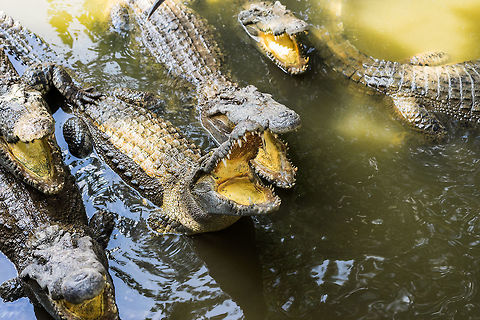
Behavior
Despite conservation concerns, many aspects of "C. siamensis" life history in the wild remain unknown, particularly regarding its reproductive biology.Adults feed mainly on fish and snakes, but also eat amphibians and small mammals.
Very little is known about the natural history of this species in the wild, but females build mound-nests constructed from scraped-up plant debris mixed with mud. In captivity, these crocodiles breed during the wet season, laying between 15 and 50 eggs, which are then guarded until they hatch. After incubation, the female will assist her young as they break out of their eggs and then carry the hatchlings to the water in her jaws.
Pure, unhybridised examples of this species are generally unaggressive towards humans, and unprovoked attacks are unknown.
Cultural
A Siamese crocodile stars as the titular monster in the 1978 Thailand film "Crocodile".References:
Some text fragments are auto parsed from Wikipedia.